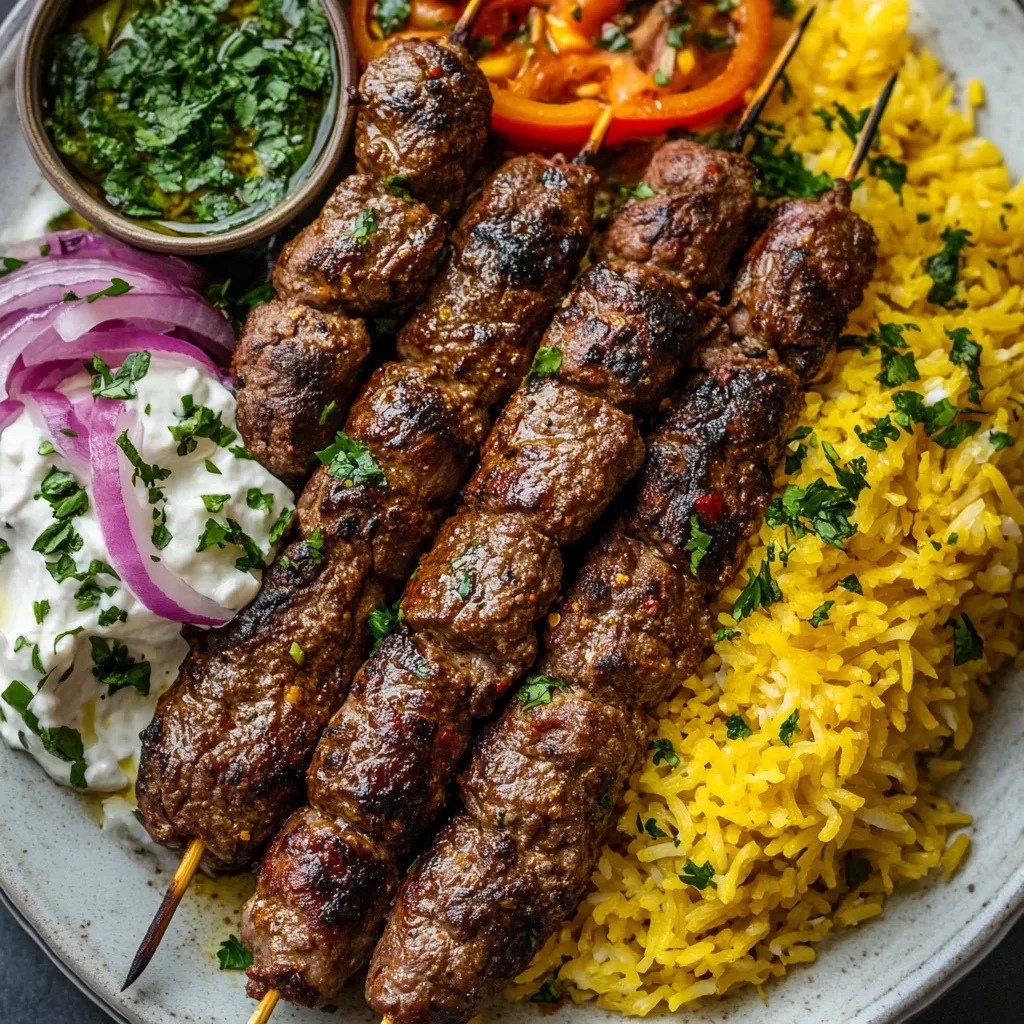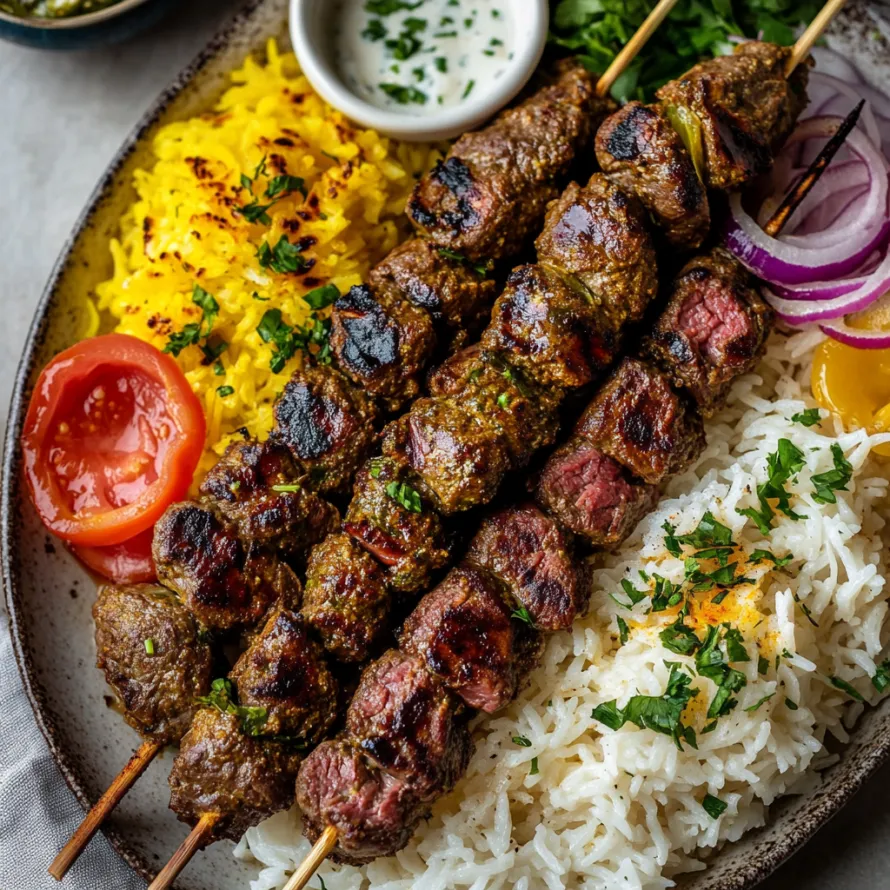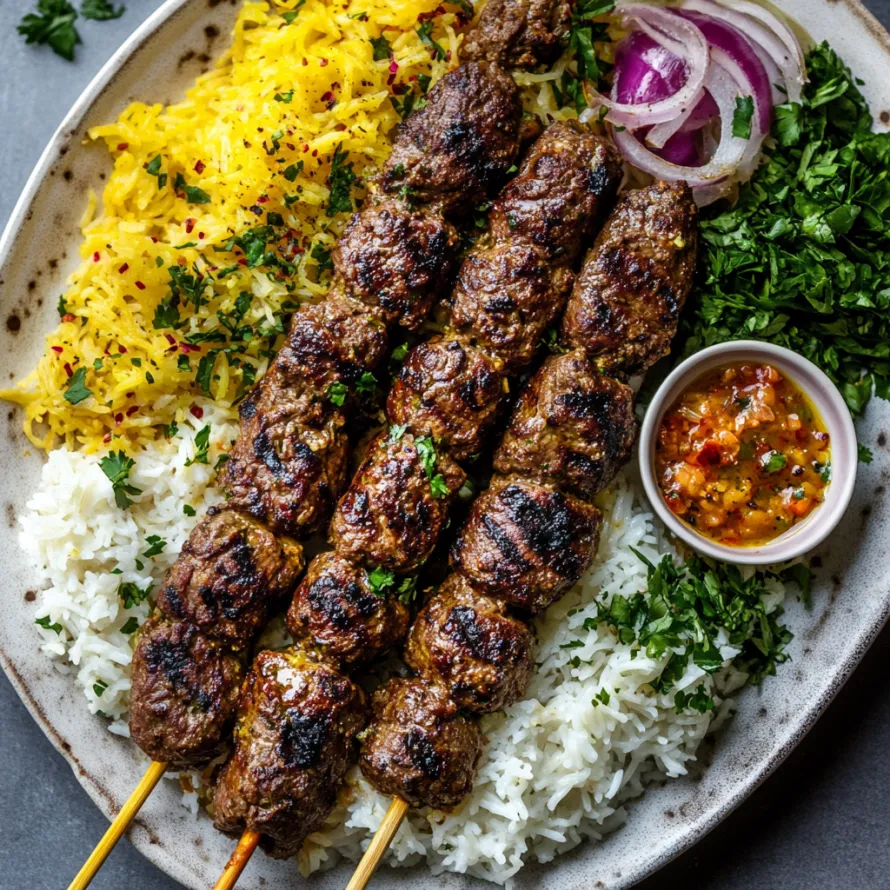 Pin
Pin
I've been turning to this classic Persian ground beef kabob for backyard cookouts and fancy dinners for ages. The richly flavored meat, wrapped around wide metal skewers and cooked until succulent, delivers authentic Middle Eastern tastes straight from your grill.
The first time I whipped up Koobideh for my Persian buddy's party, his tearful response to tasting something so reminiscent of his homeland made me realize this dish needed to become a staple in my cooking lineup.
What You'll Need
- Ground beef: Pick 80/20 fat content for maximum juiciness and proper texture
- Onion: Provides needed moisture and builds the fundamental flavor profile
- Garlic cloves: Gives richness without taking over the meat's taste
- Paprika: Adds gentle color and soft pepper notes
- Sumac: Crucial for that zingy tang that defines Persian cooking
- Kosher salt: Pulls out all flavors and helps the mixture stick together
- Black pepper: Grind it fresh for strongest impact
- Ground turmeric: Brings golden color and gentle earthiness
- Saffron: The key Persian element that delivers unique scent and hue
- Butter or olive oil: Creates a shiny coating and keeps meat moist
Cooking Method
- Handle the onion:
- Shred onion on a box grater then push out extra liquid using a fine strainer or kitchen towel. This keeps your meat mix from getting soggy while keeping all that onion goodness.
- Mix your meat:
- Put beef, shredded onion, chopped garlic, and all seasonings in a big bowl. Work everything together by hand until well blended and slightly tacky. This thorough mixing helps the proteins bind so the meat won't fall off the skewers.
- Let it sit:
- Stick the prepared mixture in your fridge for at least 2 hours. This key wait time lets proteins connect and fat firm up, making the meat easier to shape onto skewers and stay put during grilling.
- Make saffron liquid:
- Smash saffron threads with a spoon to wake up their oils, then drop in ice cubes to pull out color and flavor. This cold method gets more punch from your saffron than using hot water.
- Fix the saffron butter:
- Warm butter in a small pot, then pour in the saffron liquid. This makes a stunning gold basting sauce that will boost both looks and taste of your finished kabobs.
- Shape your kabobs:
- Grab some cold meat mix and push it around flat metal skewers, pressing firmly to make an even layer about half inch thick. Use your fingers to make little ridges along the kabob for that classic look.
- Grill carefully:
- Set shaped kabobs on a hot medium-high grill, letting them cook without moving for 3-4 minutes before gently flipping. This initial cooking time helps the meat stick to the skewer.
- Brush with saffron butter:
- When kabobs are almost done, slather them with saffron butter on all sides. This adds knockout flavor and gives them a pretty shine.
- Cook the veggies:
- While meat sits, throw some oiled tomatoes, onions, and peppers on the grill until they're soft and charred.

Sumac stands out as the star ingredient for me. Its bright, lemon-like kick perfectly balances the rich meat. I'll never forget when my father-in-law, who rarely notices food details, specifically asked what gave everything that lively tang the first time I served this.
No Special Skewers Needed
Don't worry if you can't find traditional flat Persian skewers. Just shape the meat into long oval patties about 5 inches in length and 1 inch thick. Cook them right on your grill grates or in a cast iron pan with a bit of oil. They won't have that classic look, but they'll taste just as amazing and go perfectly with rice and grilled veggies for a true Persian meal experience.
Traditional Serving Ideas
The classic way to enjoy Koobideh is with golden saffron rice and charred tomatoes. For a full Persian spread, add Mast o Khiar (cucumber yogurt with herbs), bunches of fresh herbs (mint, basil, radishes), and thin lavash bread. A little sumac sprinkled over everything makes it complete. Try adding a simple mix of diced cucumbers, tomatoes and red onions tossed in lemon juice and olive oil for a cool contrast.
Heritage Importance
Koobideh plays a central role in Persian food traditions. Its name comes from "koobidan" which means "to pound" in Persian, showing how the meat was once pounded with wooden tools until super fine. You'll find this dish at practically every Persian celebration. In authentic Iranian eateries, skilled grill masters take enormous pride in crafting perfectly uniform kabobs that stay intact on the skewer—a true sign of mastery in Persian cooking.

This dish truly brings the heart of Persian food culture to your dinner table—incredibly tasty and genuinely authentic.
Recipe Q&A
- → Why do I need to refrigerate the meat mixture for 2 hours?
Chilling the meat mix really matters because it lets the fat harden, which makes everything stick together better when you put it on skewers. This cold time stops the meat from dropping off while cooking and helps you get that perfect Koobideh shape.
- → Can I use regular skewers instead of flat Persian skewers?
Flat Persian skewers work best since they keep the meat from spinning and spread heat evenly, but you can make Koobideh without them. Just shape the meat into long logs by hand and grill them directly. The flavor will stay true, but they won't look exactly like traditional ones.
- → What is sumac and is there a substitute?
Sumac gives a bright, lemony kick that's key to Koobideh's special taste. It's common in Middle Eastern dishes. If you can't find it, try mixing lemon zest with paprika instead. The flavor won't be quite the same, but it'll work in a pinch. Your best bet is checking ethnic food stores or shopping online.
- → How do I create the signature ridges on the kebabs?
Those famous grooves on Koobideh kebabs come from using your thumb and finger to make little dents along the meat after you've wrapped it around the skewer. This isn't just for show. These indentations actually help your kebabs cook more evenly by creating spots of different thickness.
- → Can I prepare the meat mixture in advance?
You can definitely mix your meat up to a day ahead and keep it in the fridge. This actually makes it taste better since the spices get more time to blend with the meat. Just make sure you cover it well so it doesn't dry out or pick up weird smells from other foods.
- → What's the purpose of the saffron butter?
That saffron butter isn't just fancy. It adds moisture and rich flavor to your kebabs. The butter carries saffron's unique taste through the meat and gives everything a nice golden color. We brush it on near the end of cooking so it won't burn but still packs a big flavor punch.
